|
||||||
|
FAGUS. Beech. [Fagaceae] |
|
|
Beech (F. sylvatica) is the only species of Fagus recorded in Britain. It is introduced. Fifteen British miners are recorded on Fagus. A key to the European miners recorded on Fagus is provided in Bladmineerders van Europa. |
 Beech Fagus sylvatica |
|
Key for the identification of the known mines of British |
1a > Leaf-miner and case-bearer: The larva lives outside the mine, protected by a case, and feeds on the underlying plant tissues via a hole cut in the epidermis. From that point it eats away as much leaf tissue as it can reach without fully entering the mine. Mine does not contain frass (Coleophora species) |
1b > Leaf-miner, but not a case-bearer: The larva lives mainly inside the mine. Mine usually contains frass. In later instars the larva may live sandwiched between two more or less circular sections cut from the leaf. |
2 > Leaf-miner and case-bearer: The full grown larva lives in a dull black pistol case of c 9 mm that, with a mouth angle of 80-90° stands erect on the leaf. Characteristic is the presence of some ear-like flaps. At least after the hibernation the larvae do not mine any more, but rather cause skeleton feeding. |
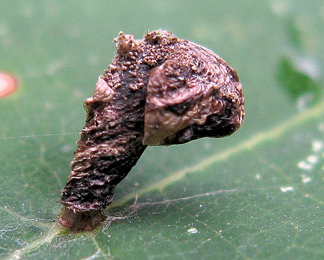 Case of Coleophora currucipennella on Quercus rubra Image: © Paul van Wielink (Bladmineerders van Europa) |
|
Coleophora currucipennella Zeller, 1839 [Lepidoptera: Coleophoridae]. |
3a > Leaf-miner: The larvae mine the leaves at first, then create small feeding windows. Small, full depth, hook-like corridor, usually in a vein axil, with a proportionally large larval chamber. The remainder of the mine almost entirely stuffed with frass. At the start if the mine an iridescent egg shell. The larvae soon leave their mine and start living free on the leaf. The pupa and white ribbed cocoon are illustrated in British leafminers. |
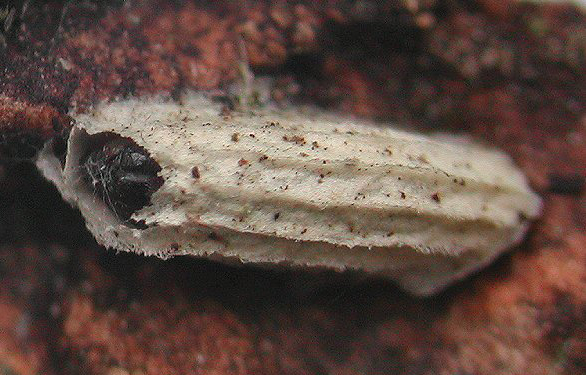 Bucculatrix thoracella cocoon Image: Rob Edmunds (British leafminers) |
|
Bucculatrix thoracella (Thunberg, 1794) [Lepidoptera: Bucculatricidae]. |
3b > Leaf-miner: The larva at first mines the leaves in a gallery leading to a blotch. Subsequently the larva forms a succession of cones (usually three) by folding the tips of the leaves, and feeding withinthem. At first a narrow lower-surface epidermal gallery, regularly intersecting itself. In the next stage the mine becomes full depth. It remains a small mine, either rectangular, or, more frequently, a triangle in a vein axil, with frass along the sides. After a while the mine is vacated and the larva continues in a leaf roll. No differences, either the mine or in larva, are known from C. robustella. Moreover a temporal overlap exists between the single larval generation of C. alchmiella, and the second larval generation of robustella. Pupation in a white cocoon. Only the pupae and adults enable a reliable identification. |
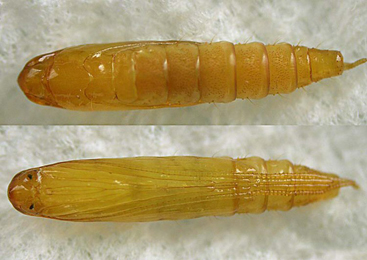 Pupae of Caloptilia alchimiella Image: © Charlie Streets (British leafminers) |
|
Caloptilia alchimiella (Scopoli, 1763) [Lepidoptera: Gracillariidae]. |
3c > Leaf-miner: Initially in short gallery becoming a blotch in the leaf. Later in up to three cones at the edge of the leaf. The mines and cones are the same as for Caloptilia alchimiella and the moth needs to be bred out to confirm identity. Mine indistinguishable from that of Caloptilia alchimiella. The pupa forms in a cocoon under a turned over leaf edge. |
|
Caloptilia robustella Jäckh, 1972 [Lepidoptera: Gracillariidae]. |
3d > Leaf-miner: In the first instar the larva mines the leaves, forming short, irregular, blotch-like mines, but in later instars it lives externally, feeding in spun leaves and often twisting those of tender shoots. Larval head light-brown or yellowish brown, edged with black postero-laterally, ocellar area blackish; prothoracic plate black edged with whitish anteriorly; abdomen dull dark green; pinacula distinct, black, sometimes brownish but with black bases to setae; anal plate large, black (Bradley et al., 1973). Small, full depth mine without a definite shape; little frass. Some silk is deposited in the mine. The larva soon leaves the mine and continues feeding among spun leaves. |
|
Cnephasia incertana (Treitschke, 1835) [Lepidoptera: Tortricidae]. |
3e > Leaf-miner: The larvae mine leaves at first, forming a blotch mine, later descending to the ground in a portable case and feeding on dead leaves. Oviposition is by way of an ovipositor, therefore no egg shell visible. The larva makes a small, roundish, blotch; often several in a leaf. Already after its first moult it makes an excision out of the mine, in size almost equal to the blotch (3-4 mm). Thus sandwiched it drops to the ground and continues feeding on dead leaf material. |
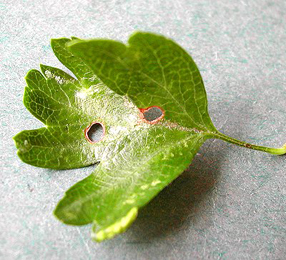 Mines of Incurvaria masculella Image: © Rob Edmunds (British leafminers) |
|
Incurvaria masculella (Denis & Schiffermüller, 1775) [Lepidoptera: Incurvariidae]. |
3f > Leaf-miner: Oviposition by way of an ovipositor, no egg visible therefore. The larva makes an irregular blotch. The part of the mine nearest to the oviposition site is more thranslucent than the later, in transparancy more greenish, part of the mine. The mine usually lies close to the leaf tip, often several together. After its first moult the larva makes a roundish excision, 3-4 mm in diameter. Incurvaria larvae, while resting, take a horse-shoe like posture, unlike the larvae of Antispila species. Sandwiched herein it drops to the ground and continues feeding of dead leaves. The excision occupies about half of the surface of the blotch. The mine is also described in. |
|
Incurvaria oehlmanniella (Hübner, 1796) [Lepidoptera: Incurvariidae]. |
3g > Leaf-miner: The mine starts as a corridor at the midrib and ends in a blotch (British leafminers, as Salius fagi). Oviposition in the underside of the midrib, rarely in a thick lateral vein. At this site the vein swells, and splits open over a few mm. The larva begins by making a short mine in the midrib, but soon enters the blade with an initially narrow, but gradually widening corridor that generally runs towards the leaf tip. The final part of the mine is a broad blotch that generally occupies a sizable part of the leaf tip or leaf margin. Frass in the corridor part in an indistinct central line, higher up it is irregular, often also in longer threads. At the end of May a globular cocoon is secreted by the larva inside the mine where pupation takes place.The mine is initially whitish, but it soon turns brown. Later the mine withers away totally, but the infestation remains visible in the ravaged leaves, that still show the oviposition scar and often also the first part of the corridor. |
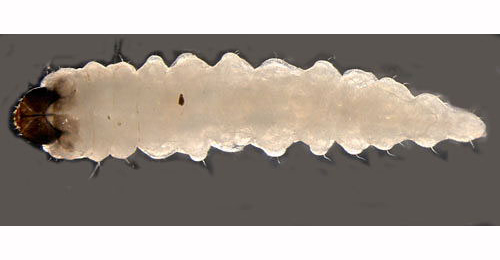 Orchestes fagi larva, dorsal Image: © Willem Ellis (Bladmineerders van Europa) |
|
Orchestes fagi (Linnaeus, 1758) [Coleoptera: Curculionidae]. |
3h > Leaf-miner: Early mine a blotch with upper epidermis turning brown. Then a fold at the leaf edge or tip of the leaf. Often two or three folds can be seen. Initially a small lower-surface epidermal corridor with reddish brown frass, a small rectangular full depth blotch with black frass later. Lower, later also the upper, epidermis brown. The larva deposits only little silk in the mine, that therefore remains practically flat. Finally the larva leaves the mine and continues living free under a folded leaf margin or leaf tip. |
|
Parornix fagivora (Frey, 1861) [Lepidoptera: Gracillariidae]. |
3i > Leaf-miner: The mine is in the upper epidermis of a leaf, usually over midrib or vein. The mine is at first silvery, later with brown speckling. Silvery, upper-surface, epidermal tentiform mine, centered over the midrib or a heavy lateral vein. Unlike P. leucographella, with which this species shares some host plants, the upper epidermis looks dirty by the presence of numerous fine black-brown specks of frass. The epidermis remains without folds until the mine becomes strongly contrated. Young mines look like a streak of silver on top of a vein. |
|
Phyllonorycter corylifoliella (Hübner, 1796) [Lepidoptera: Gracillariidae]. |
3j > Leaf-miner: The mine is upper side and silvery, over the midrib. Leaf later may fold upwards, concealing the mine. Oviposition is on the base of the midrib. From there an epidermal corridor is made, running towards the leaf tip. The corridor then is widened into an epidermal, silvery blotch, finally into a longitudinally contracted tentiform mine. Frass in fine, shining grains, mostly in a line over the midrib, rarely in a mass in a corner of the mine. The epidermis of the mine has a number of yellow spots, but never the black specks that are apparent in P. corylifoliella.). |
|
|
|
Phyllonorycter leucographella (Zeller, 1850) [Lepidoptera: Gracillariidae]. |
3k > Leaf-miner: A long mine between veins, several creases in lower epidermis. It is strongly contracted, forming a tubular shape. Oviposition at the underside of the leaf, always near a side vein. The mine begins as an elongate blotch of 5-7 mm alongside the vein. This develops into an elongate lower-surface tentiform mine between two side veins, sometimes from midrib to leaf margin. Contraction of the lower epidemis may give the mine a tubular aspect. The lower epidermis has a number of fine folds that are set so close together as to appear one single strong fold. Al frass is heaped in a corner of the mine. The pupa lies in a loose, white, membranaceous cocoon in the opposite corner. |
|
Phyllonorycter maestingella (Müller, 1764) [Lepidoptera: Gracillariidae]. |
3l > Leaf-miner: The mine is oval on Q. ilex (note - there may be several mines in the leaf), and similar to P. quercifoliella on deciduous oaks. It is between adjacent veins on beech and hornbeam. Small, oval, lower-surface tentiform mine, 9-14 mm long, mostly between two lateral veins. The lower epidermis with a single sharp fold (sometimes forked near its end). Pupa in very flimsy cocoon, that contains a bit of frass laterally and at the rear end. |
|
Phyllonorycter messaniella (Zeller, 1846) [Lepidoptera: Gracillariidae]. |
3m > Leaf-miner: A gallery, with coiled frass in central part. Oviposition generally at the upperside of the leaf, and not far from the leaf margin. The mine is a rather wide corridor, that often crosses a vein, and almost invariably runs from somewhere near the leaf margin in the direction of the midrib. Its first part is quite narrow, with a narrow central frass line. The next section is wider, and here the frass is distinctly coiled. In the final section the frass lies somewhat more irregular, and in a rather narrow central zone. |
|
Stigmella hemargyrella (Kollar, 1832) [Lepidoptera: Nepticulidae]. |
3n > Leaf-miner: A gallery completely without coiled frass. Ovipisition at the underside of the leaf, in the axil of a vein. From there a corridor, that does not widen much, zigzags between two lateral veins in the direction of the leaf margin. Frass at first in a narrow central line. Later the frass becomes widely dispersed; it never lies in coils. |
|
Stigmella tityrella (Stainton, 1854) [Lepidoptera: Nepticulidae]. |
| Last updated 05-Jul-2019 Brian Pitkin | ||
